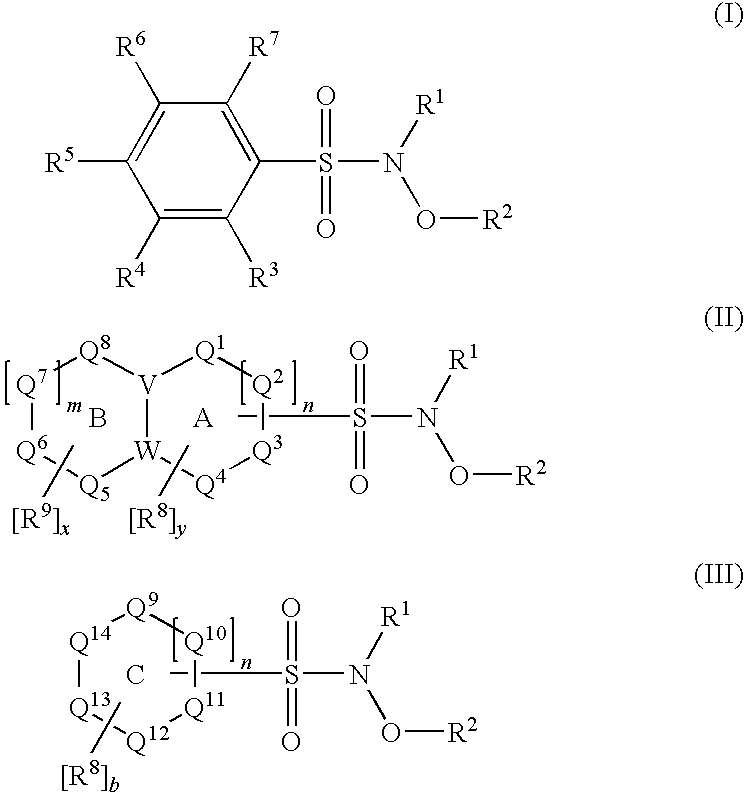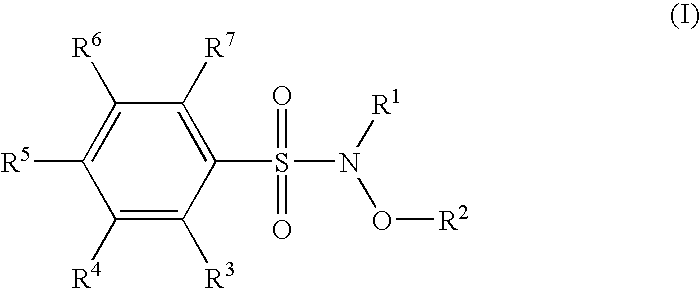N-hydroxylsulfonamide derivatives as new physiologically useful nitroxyl donors
a technology of nitroxyl donor and n-hydroxylsulfonamide, which is applied in the direction of metabolism disorder, extracellular fluid disorder, peptide/protein ingredient, etc., can solve the problems of exercise intolerance, subsequent decline in heart function, and heart failure, so as to protect against myocardial ischemia/reperfusion injury, increase ischemia/reperfusion injury, and control vascular tone
- Summary
- Abstract
- Description
- Claims
- Application Information
AI Technical Summary
Benefits of technology
Problems solved by technology
Method used
Image
Examples
example 1
Preparation of Compounds of the Invention According to General Synthesis of Scheme A
2-Hydroxysulfamoyl-benzoic Acid Methyl Ester (Compound 1)
[0120]
[0121]A solution of potassium carbonate (3.53 g, 25.57 mmol) in water (3.6 ml) was added dropwise to a solution of hydroxylamine hydrochloride (1.76 g, 25.57 mmol) in water (2.4 ml) at 0° C. maintaining an internal reaction temperature between 5° C. and 15° C. THF (12 ml) and methanol (3 ml) were added, followed by 2-chlorosulfonyl-benzoic acid methyl ester (3 g, 12.78 mmol) portionwise maintaining a temperature below 15° C. and the reaction mixture was stirred at ambient temperature until complete consumption of the sulfonyl chloride was observed by tlc. The resulting suspension was concentrated to remove any volatiles and the aqueous suspension was extracted with diethyl ether (2×100 ml). The organic portion was dried over sodium sulphate, filtered and concentrated in vacuo to yield the crude N-hydroxy sulfonamide. Purification was achi...
example 2
Preparation of Compounds of the Invention According to General Synthesis of Scheme A
3-Hydroxysulfamoyl-benzoic Acid (Compound 2)
[0122]
[0123]A solution of potassium carbonate (0.43 g, 3.10 mmol) in water (1.2 ml) was added drop wise to a solution of hydroxylamine hydrochloride (0.21 g, 3.10 mmol) in water (0.8 ml) at 0° C. maintaining an internal reaction temperature between 5° C. and 15° C. THF (4 ml) and methanol (1 ml) were added, followed by 3-chlorosulfonyl-benzoic acid (0.34 g, 1.55 mmol) portion wise maintaining a temperature below 15° C. and the reaction mixture was stirred at ambient temperature until complete consumption of the sulfonyl chloride was observed by LCMS. The resulting suspension was concentrated to remove any volatiles and the aqueous suspension was extracted with diethyl ether (2×100 ml), and the combined organic layers were discarded. The aqueous layer was acidified to pH=1, adding a solution of hydrochloric acid (2N) drop wise, then extracted with diethyl et...
example 3
Kinetics of HNO Release
[0148]The decomposition rates of the compounds may be determined by UV-Vis spectroscopy.
[0149]The decomposition of compounds may be monitored by UV-Vis spectroscopy in 0.1 M PBS buffer at pH 7.4 and 37° C. Bonner, F. T.; Ko., Y. Inorg. Chem. 1992, 31, 2514-2519.
PUM
| Property | Measurement | Unit |
|---|---|---|
| Responsivity | aaaaa | aaaaa |
| Level | aaaaa | aaaaa |
Abstract
Description
Claims
Application Information
 Login to View More
Login to View More - R&D
- Intellectual Property
- Life Sciences
- Materials
- Tech Scout
- Unparalleled Data Quality
- Higher Quality Content
- 60% Fewer Hallucinations
Browse by: Latest US Patents, China's latest patents, Technical Efficacy Thesaurus, Application Domain, Technology Topic, Popular Technical Reports.
© 2025 PatSnap. All rights reserved.Legal|Privacy policy|Modern Slavery Act Transparency Statement|Sitemap|About US| Contact US: help@patsnap.com



